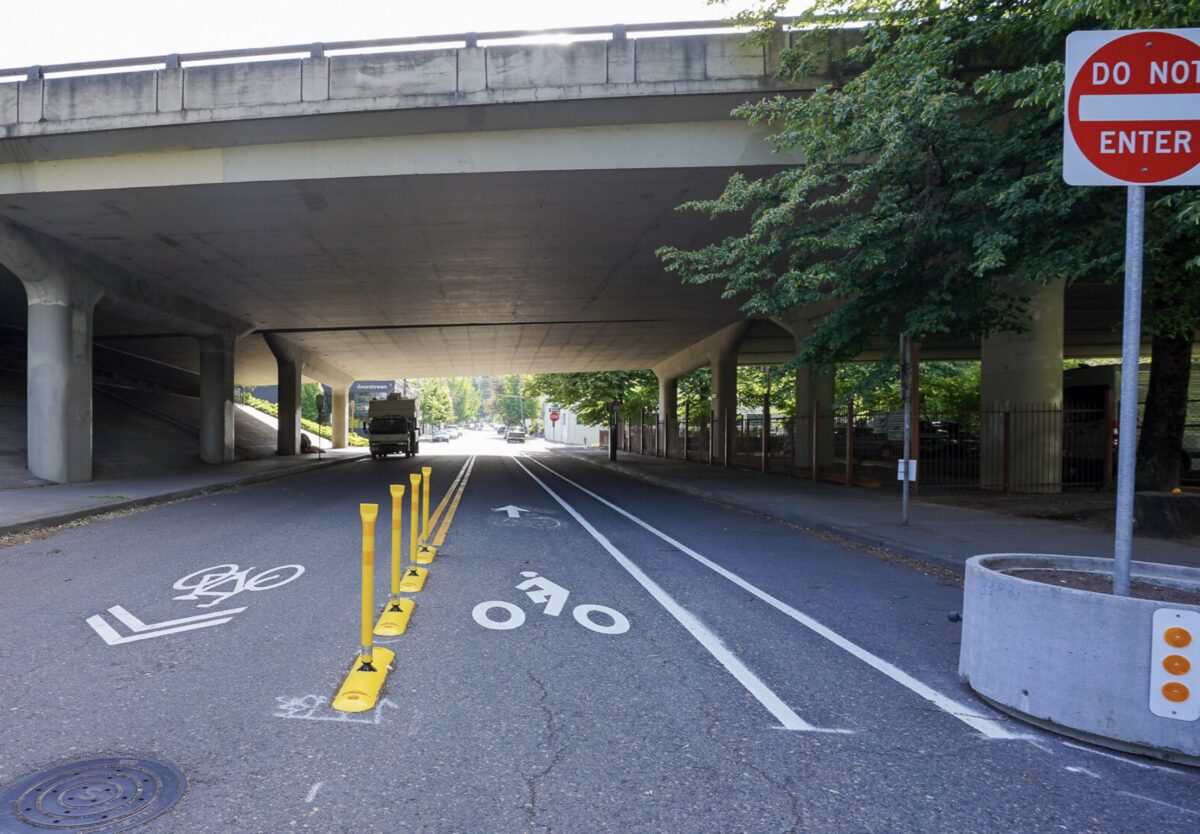
(Photo: Jonathan Maus/BikePortland)
When the Portland Bureau of Transportation debuted its Northwest in Motion (NWIM) plan in 2020, biking and transit advocates were excited about the opportunity to change how Northwest Portlanders get around. One year later and with a significant amount of projects implemented, it’s time to take stock of the vision.

(Photo: PBOT)
We’ve reported about the importance of bike infrastructure in Northwest Portland before: this is a dense part of the city where people are much more likely not to own cars, and people who do drive often take short trips that are less than three miles long. This provides a good opportunity to promote bike use in Northwest Portland – if there is infrastructure that allows people can do so safely.
At the time of NWIM implementation, northwest Portlanders were bicycling a lot less than people who lived in other parts of the city. In the NWIM report, PBOT says this is because the “neighborhood greenway network [in NW Portland] is overrun with vehicle traffic and does not offer the same low-stress cycling environment that has made bicycling so common in the Inner Eastside.”
Because of its density, northwest Portland is an area that will become easily stressed and overwhelmed by increased car use. In the NWIM report, PBOT says that for this reason, “projects are needed in the near-term to make other modes of travel more attractive options.”
After surveying the community for two years to identify the most important problems facing Northwest Portlanders who bike, walk or use public transportation, PBOT identified a few key areas to focus on: neighborhood greenways and corridor improvements. The city then split projects for each category into into two tiers based on priority and funding availability.
Neighborhood greenways, which are low-stress neighborhood streets that prioritize people walking and cycling, are a crucial part of Portland’s cycling network. NW Portland had a designated neighborhood network, but, according to PBOT, none of those streets had “the adequate traffic calming or low traffic volumes needed to make the streets accessible to riders of all ages and abilities.”
In the last year, PBOT has redesigned the neighborhood greenways on NW Johnson St, NW Marshall St and NW 24th Ave through the NWIM project by adding speed bumps, enhanced busy street crossings and diverting traffic to reduce speeds and volumes.
These particular projects make up a chunk of the NWIM goal for the greenway network, which PBOT hopes will eventually allow everyone to access nearly every destination in northwest Portland on foot or bike while remaining on the greenways. Other Tier 1 greenway projects in the larger NWIM plan include building entirely new greenway systems on NW Pettygrove/NW Overton St and NW Savier St.
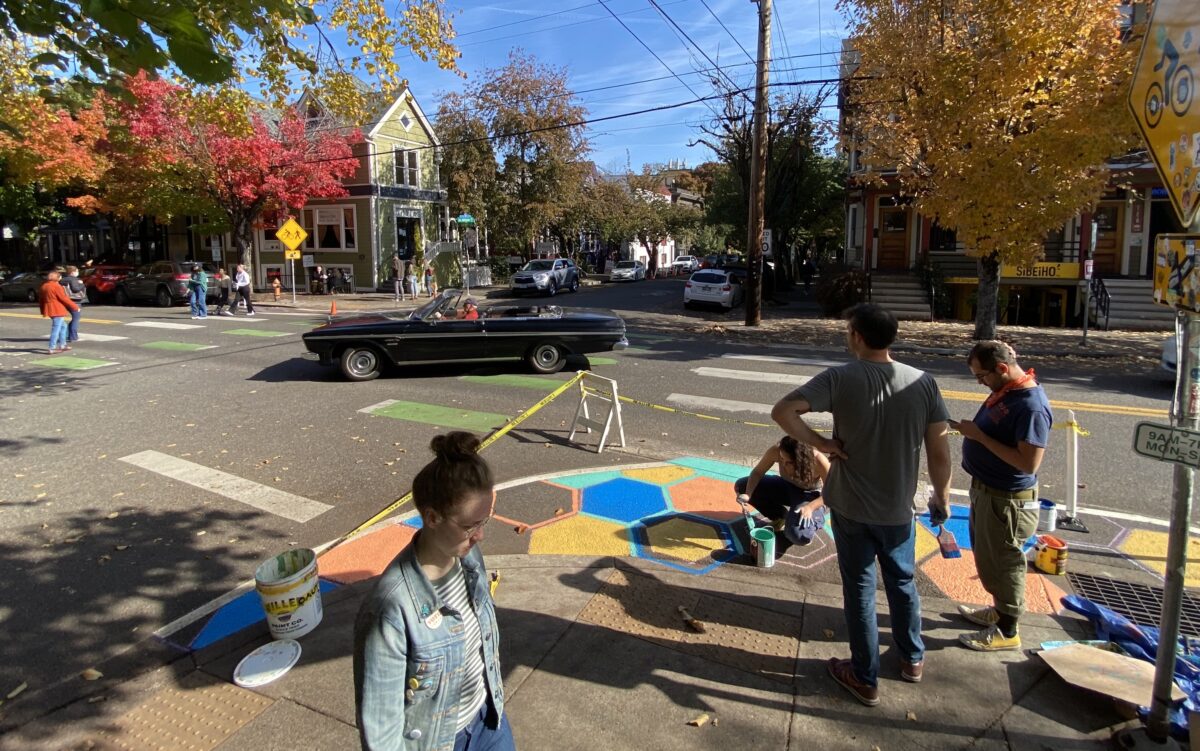
(Photo: Jonathan Maus/BikePortland)
Corridor improvements are intended to improve safety and accessibility for people walking, biking or riding transit by doing things like adding new pedestrian crossings and speed bumps and adding bus platforms to reduce bus/bike conflicts. Through the first year of NWIM, corridor improvements have been implemented at NW 25th/Westover, NW 23rd Ave, NW 18th/19th Ave and NW Everett/Glisan St.
The city has been able to fund projects like these through revenue streams that other parts of the city don’t have access to. Specifically, a portion of the district’s parking and permit revenue is designated toward projects like NWIM, with the goal of reducing the unsustainable demand for parking downtown.
This means that the NWIM projects may be completed sooner compared to projects in other ‘in motion’ plans, like in East Portland, where some advocates have been calling on PBOT to act faster on active transportation improvements.
Advertisement
PBOT says they’ll continue to evaluate the success of the projects to determine whether more changes should be made and if more projects are warranted.
Some of the tactics PBOT used for the NWIM projects that have already been implemented — like paint-and-post curb extensions and modular bus platforms — were pretty quick and easy to get going, but may not be permanent. If evidence shows these ideas have been successful, PBOT may permanently enact them or even expand them citywide.
Along with the NWIM-recommended greenway and crossing improvement projects, PBOT also built the Flanders Crossing bridge over I-405 and implemented the NW Flanders Bikeway, which connect Northwest Portland to the Pearl District, Old Town Chinatown, and Waterfront Park.
Going forward, PBOT says Northwest Portlanders can expect to see the NW Pettygrove St Neighborhood Greenway connecting Wallace Park, Slabtown, and Fields Park, as well as NW Vaughn St Corridor Improvements to improve crossing and bike lane safety for people walking and biking, among other planned projects.
PBOT planners say they’re happy with the progress that has been made in northwest Portland, and continue to work towards the goal of changing the district’s transportation system to encourage a lot less driving.
“We’re proud of the rapid progress that’s been made over the past year as we work to realize a more walkable, bike-friendly, and sustainable transportation system in Northwest Portland,” a PBOT press release on the one-year update says.
You can read more about the one-year NWIM update here.


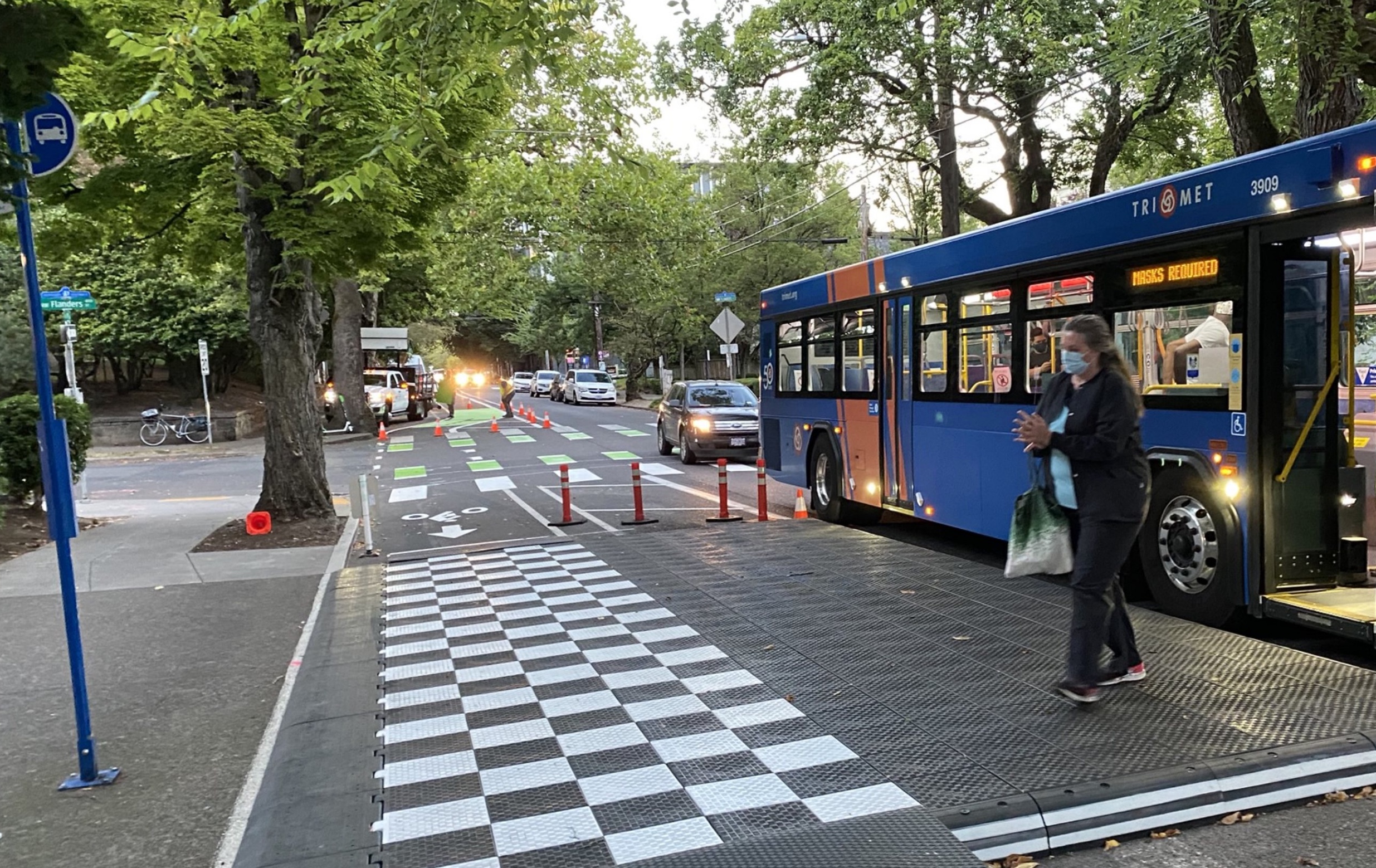

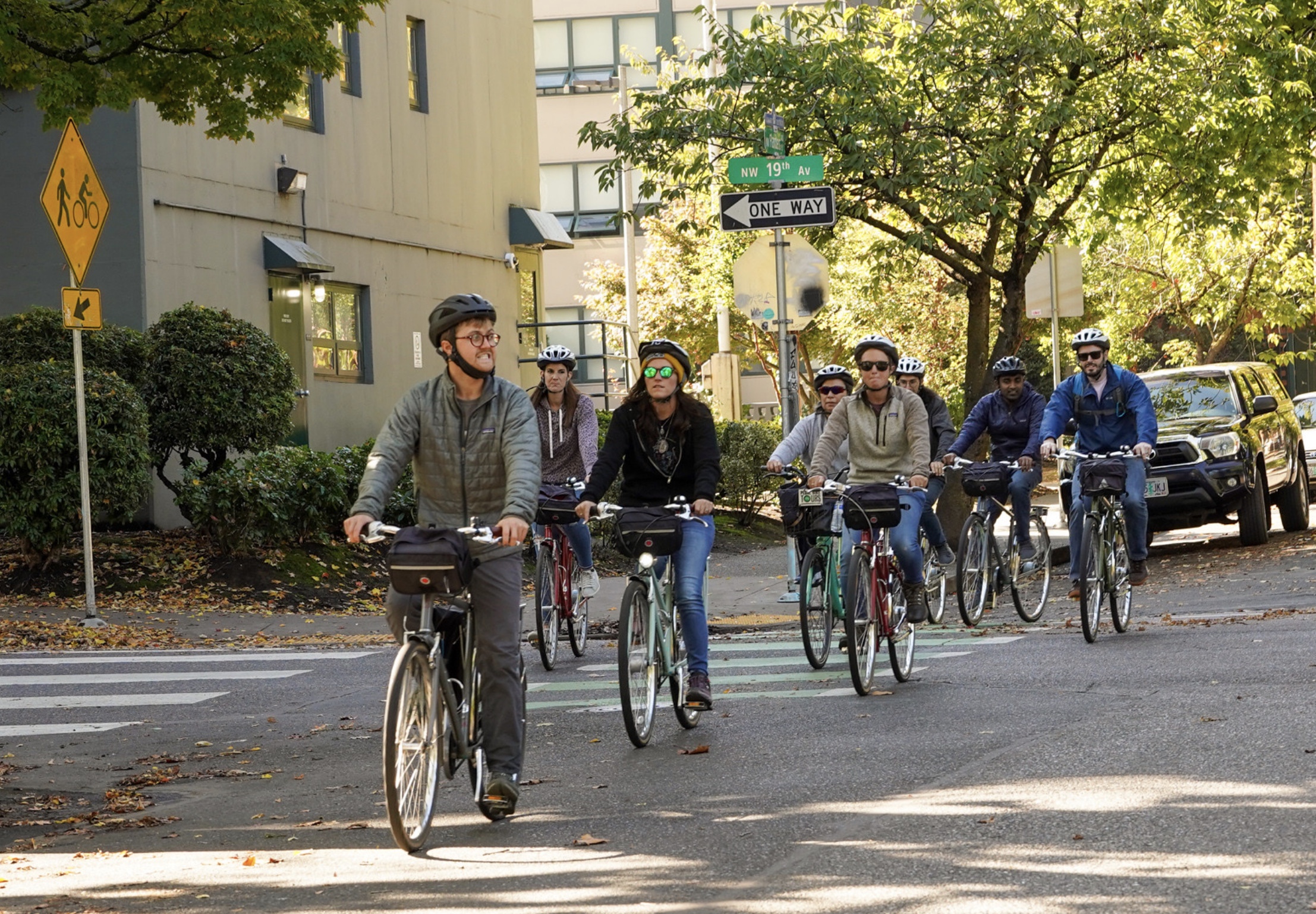

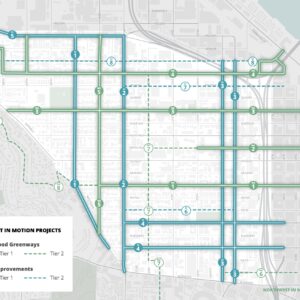
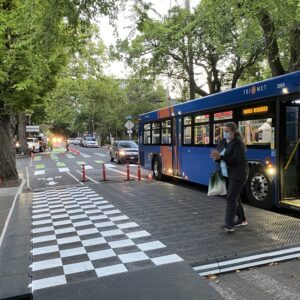
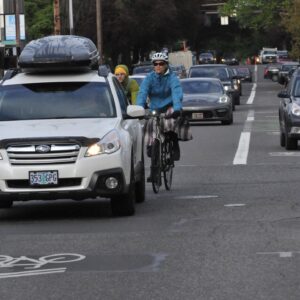

Thanks for reading.
BikePortland has served this community with independent community journalism since 2005. We rely on subscriptions from readers like you to survive. Your financial support is vital in keeping this valuable resource alive and well.
Please subscribe today to strengthen and expand our work.
“implemented the NW Flanders Greenway” and then allowed a developer to completely block an entire block of the greenway (4th to 5th) and fence off the sidewalk. A network is only as good as it’s weakest link, and missing links like this really undermine the entire network. Especially since Flanders is the only designated accessible from the waterfront north of Burnside.
Definitely not saying it is good construction traffic control, but that stretch is fenced off to autos, not bikes. People waking and biking can get through most of the time.
After being really excited for the Flanders overcrossing, I unfortunately had to be disappointed in the Flanders greenway – I rode it a lot after that link was put in before I moved out of the neighborhood. You can squeeze past this construction, but most of the route is constant stop signs and very poorly maintained pavement. I don’t ride very fast and will happily take slower routes to avoid stress, but even with that said I sometimes found myself just getting on Everett with automobile traffic so I could move less hindered.
As a new-ish resident of about 1 year to the neighborhood who was also really excited about Flanders, I totally agree. Access from Naito/the waterfront park where I live is almost impossible, and with a stop sign almost every block, not to mention the construction and poorly maintained pavement, the Flanders route is basically useless. The new bridge across the highway is nice, but there are also bike lanes going across the highway on Everett and Glisan, where I’m guessing many bicyclists can come close to maintaining the speed of traffic that is dictated by the traffic light patterns. I’m honestly less stressed by riding with the traffic on those streets than dealing with cross-traffic at every block.
I find this very frustrating too. It’s usually possible to squeeze by, but often only by riding on the sidewalk, which is a far from ideal situation.
While it doesn’t excuse anything, I will note that the developer of the new building is Central City Concern and the building will be providing housing for very low income people.
“While it doesn’t excuse anything, I will note that the developer of the new building is Central City Concern and the building will be providing housing for very low income people”.
To be PC I believe it’s referred to as “affordable housing”.
If you want to see some really bad construction traffic management visit Division St. between 82nd and 92nd.
It’s affordable housing, yes, but the reason I chose that phrasing is because almost all the units in this building will serve people at 0-30% of Area Median Income who would otherwise be homeless.
Seems like Allan Classen has calmed down – no articles about “bike zealots” on a while:
https://bikeportland.org/tag/allan-classen
He hasn’t calmed down, he’s just too preoccupied with writing about himself as a moral crusader against democracy-crushing censorship when the coalition org asks him for his preferred pronouns or otherwise defending the good ol’ boys’ club in the NWDA.
(please read with the appropriate level of sarcasm)
I really can’t give Portland or PBOT a pat on the back for anything until they put sidewalks and paved streets east of 82nd in the neighborhoods they forcefully annexed for their taxes.
This is a great plan. Using a lot of paint and temporary structures PBOT will attempt to secure better bike infrastructure, at what we presume to be a minimal cost, to a neighborhood that is building almost 1000 units of affordable housing (I may have the numbers wrong).
This is a good investment.
I think the improvements made so far have been solid in their efficacy and speed of installation; and I look forward to their continued evolution and eventual beautification.
However, as with the rest of the city, it is way past time that effective bike infrastructure is installed on our main streets (eg, 21st and 23rd in NW). This would be good for Portlanders who bike and a boon for business-folks.
If I were in charge of PBOT, 21st and 23rd—plus all the other similar-sized commercial streets masquerading as arterials like Alberta and Mississippi (as opposed to actual arterials like Burnside, Sandy, 82nd, etc. which *should* have PBLs)—would be fully pedestrianized, which would be a lot cheaper and provide a better overall experience than replacing parking with protected bike lanes (i.e. what the Bike Plan seems to imply). It would, of course, still be possible/encouraged to bike through them in the middle of the street, with sidewalks and outdoor seating on either side. Literally all it would take is some planters and paint.